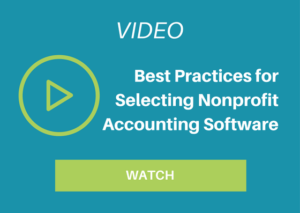In the mission-driven nonprofit world, fund accounting software can sometimes slip down the priority list. It’s not always easy to allocate budget dollars to back-office infrastructure that doesn’t directly support the nonprofit agenda and harder to find the time and expertise to make it all work. Some of the obstacles include:
- Capital investment for software and hardware
- Facilities and expert personnel to implement and maintain the system
- Lengthy deployment cycles
- Capacity/Scalability
- Reliability/availability
These kinds of issues aren’t part of most nonprofit organization’s core competencies. That’s why many nonprofits are increasingly turning to cloud-based financial management solutions. As you consider shifting to the cloud, however, you may have or hear of misconceptions about the realities of this technology:
- It’s expensive. The opposite is actually true. With on-premises systems, you have to pay for infrastructure, licensing, support, and upgrades. It’s also important to consider the value of the time your employees spend on IT-related tasks. With a cloud-based SaaS solution, you simply pay an ongoing subscription fee. This typically covers all the hardware and software expenses, including maintenance, support, and upgrades. Because SaaS cloud applications usually reside in a shared or multi-tenant environment, the hardware and software license costs are lower than the traditional model. It’s all about economy of scale.
- It’s too complicated to use and maintain. Again, the opposite is true. SaaS applications are web-based, which means they can usually be accessed and used anywhere on any Internet-enabled device. There’s no complicated software to download or maintain. In addition, SaaS offerings include best practices and samples. You can do proof of concepts and test the software functionality or a new release feature in advance.
- It won’t work with my existing systems. You need a financial management solution that integrates with your industry-specific or legacy applications. Contrary to what you might think, the cloud is all about flexible integration. Most SaaS solutions support a wide variety of sources and connectivity methods. In addition, they often seamlessly integrate with other cloud applications, so you can create a best-in-class solution that works best for your organization.
- It can’t support the needs of my growing organization. Success brings growth, which brings complexity. Your fund accounting system needs to seamlessly handle an increasing number of users—remote and onsite. With traditional on-premises systems, you have to add a server or invest in more software if you want to add more users. In cloud environments, the job of managing scalability belongs to your solution provider.
- It’s less secure. Nonprofits are entrusted with sensitive data, which is subject to numerous privacy and security regulations. Cloud vendors have the ability to invest significantly more in security than a typical organization. They often have SSAE 16 or similar audit controls to ensure your data is protected, and information is stored in highly secure data centers.
The amazing realities of cloud financial management
Cloud financial management solutions like Sage Intacct deliver shared, scalable services that you can access from any Web browser or mobile device. There’s no need to buy, own, license, understand, manage, or control the underlying hardware, software, or data/networking infrastructure that supports the financial infrastructure. Because the software is delivered on a term-based subscription basis, there’s no need for upfront software licensing fees or major purchases of hardware. The result is cost-effective, anytime/anywhere managed access. To help your nonprofit realize the cost-saving, efficiency-boosting realities of cloud fund accounting, contact JMT Consulting today.
 |
